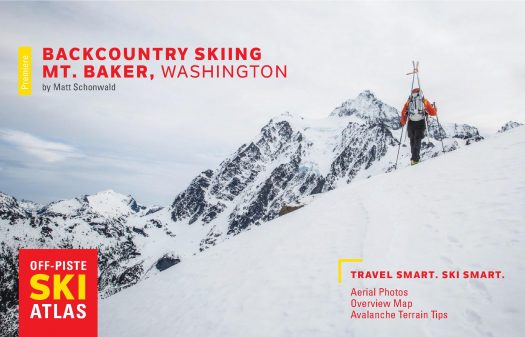The Baker Ski Atlas was recently released, and is available here. Also, there is a release party tonight in Seattle, more info here.
This post sponsored by our publishing partner Cripple Creek Backcountry, where you can get any of the Colorado Off Piste Guides, and perhaps pick one up for your springtime PNW corn foray.
It’s hard to believe it’s been almost ten years since I first explored the Mount Baker backcountry of Washington. When I learned of the stormy North Cascades as a teenager, it was shrouded in an aura of mystery. I had visions of sullen, silent locals in thick black Gore-Tex suits, clutching Starbucks coffee cups as they trudged through heavy snow below a grey cloud-choked sky. A bit like Mordor, but with pow. If this version of Mordor had the deepest snowpack in the United States, it would be pretty tempting. So I tried it.
Baker turned out to be an incredible place — and the locals were even pretty nice. Nice enough that I eventually decided to become one (I’m still not much of a coffee drinker though).
The Baker backcountry was initially intimidating. The terrain, weather, and conditions are quite different than back home in the high desert of the Colorado Rockies. I was often stymied by route-finding or strange snow conditions. Some of the outings were fun and I wouldn’t change them, but not always. Along with a smattering of challenges, I would have loved to have access to a modicum of info outlined in compact guidebook illustrated with crisp aerial photos. Hmm, maybe like a guidebook from Off Piste Ski Atlas publishing?

I dug this photo up from my first PNW trip report, all the way back in 2008. Good memories exploring the beautiful Baker backcountry for the first time.
The new Baker guidebook is Off-Piste Ski Atlas’ second book covering a PNW locale, the other being their Snoqualmie Pass guidebook published last year. The company is based in Colorado, and has also published books for Silverton and Crested Butte, with more in the works (including some kind of odd ‘easy tours’ book by my dad).
Although the books are published under one roof, they utilize different authors for different areas. Matt Schonwald, a PNW guide, has written the Snoqualmie and Baker books. The Atlases are a bit of a fresh look at ski guidebooks. Light on words, and heavy on aerial photos and other graphics. They shy away from detailed route descriptions in favor of showing lots of options with little information. The result is something that is small, light, and a bit more like a climbing guidebook than a traditional “encyclopeadic” ski touring guidebook.
I do have a deep love of classic “wordy” guidebooks, the ultimate example probably being the hefty Cascade Alpine Guide series. The “Becky Bible” is in fact larger, and maybe contains more obscure info, than the actual Bible. Many adjectives could be used to praise the Becky guides, however, “quick”, or “lightweight” would not be among them.
In contrast, it’s easy to quickly glance through the Mount Baker Ski Atlas and choose a spot to enjoy for the day. However, if you’re not a local, you might need additional info to figure out the details of a route. In many ways, I think the lack of specific info is a distinct advantage. It allows the book to showcase an incredibly large number of runs and areas in a concise way. The Baker book describes almost 100 distinct routes! Other ski guidebooks are forced to focus on a few exceptionally popular or special runs, which inevitably draws more people to the already well-known runs. The Atlas doesn’t highlight one particular run over another.
Although I spent several years exploring the Baker backcountry, I’ve recently moved farther south, and now only get up there a few times a season. Even with my now limited exposure, I’ve noticed a significant increase in the number of backcountry skiers in the area, especially in the most easily accessible area: Artist Point. Justifiably so: Artist Point and the Blueberry Chutes are easily visible from the parking lot, and offer excellent skiing. However, there’s an enormous amount of other terrain in the area that is accessible in a short day trip. Many of these other areas can be almost entirely deserted, even on a sunny weekend when there’s a five person wide skintrack up Artist point.
In view of such concentrated use as Artist point, it’s likely that the Baker Ski Atlas will inspire skiers to explore. Hopefully this will spread out the impact of the growing numbers of backcountry skiers, increasing everyone’s enjoyment and safety. Of course, I’ve got mixed feelings about this, as I love knowing where to find a easily accessible, secluded spot on a busy weekend. Indeed, the selfish side of me was pleased to notice that a few of my “secret” spots weren’t included in the Atlas.
Conclusion:
I’m not often interested in new guidebooks covering areas I’ve enjoyed for years, as they rarely include ski routes that I haven’t heard about. I’m happy to say I learned a thing or two perusing the Baker Atlas, and even added a few runs to my tick list. I recommend checking it out, you’ll find new stashes and might even retrieve the Ring.
The Baker Ski Atlas was recently released, and is available here. Also, there is a release party tonight in Seattle, more info here.
Louie Dawson earned his Bachelor Degree in Industrial Design from Western Washington University in 2014. When he’s not skiing Mount Baker or somewhere equally as snowy, he’s thinking about new products to make ski mountaineering more fun and safe.

